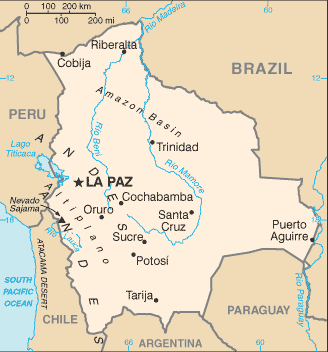 |
usa | world | animals | vocabulary | health | science | math | history |

Map Courtesy CIA World Factbook
The Republic of Bolivia is a landlocked country in central South America. It is bordered by Brazil on the north and east, Paraguay and Argentina on the south, and Chile and Peru on the west.
The Andean region probably has been inhabited for some 20,000 years. Beginning about the 2nd century B.C., the Tiwanaku culture developed at the southern end of Lake Titicaca. This culture, centered around and named for the great city of Tiwanaku, developed advanced architectural and agricultural techniques before it disappeared around 1200 A.D., probably because of extended drought. Roughly contemporaneous with the Tiwanakan culture, the Moxos in the eastern lowlands and the Mollos north of present-day La Paz also developed advanced agricultural societies that had dissipated by the 13th century A.D. In about 1450, the Quechua-speaking Incas entered the area of modern highland Bolivia and added it to their empire. They controlled the area until the Spanish conquest in 1525.
During most of the Spanish colonial period, this territory was called "Upper Peru" or "Charcas" and was under the authority of the Viceroy of Lima. Local government came from the Audiencia de Charcas located in Chuquisaca (La Plata — modern Sucre). Bolivian silver mines produced much of the Spanish empire's wealth, and Potosí, site of the famed Cerro Rico — "Rich Mountain" — was, for many years, the largest city in the Western Hemisphere. A steady stream of enslaved Indians served as labor force. As Spanish royal authority weakened during the Napoleonic wars, sentiment against colonial rule grew.
Independence was proclaimed in 1809, but 16 years of struggle followed before the establishment of the republic, named for Simón Bolívar, on August 6, 1825 (see Bolivian War of Independence).
Independence did not bring stability. For nearly 60 years, coups and short-lived constitutions dominated Bolivian politics. Bolivia's weakness was demonstrated during the War of the Pacific (1879–83), when it lost its seacoast, and the adjoining rich nitrate fields, together with the port of Antofagasta, to Chile.
An increase in the world price of silver brought Bolivia a measure of relative prosperity and political stability in the late 1800s. During the early part of the 20th century, tin replaced silver as the country's most important source of wealth. A succession of governments controlled by the economic and social elites followed laissez-faire capitalist policies through the first third of the century.
The Nationalist Revolutionary Movement (MNR) emerged as a broadly based party. Denied its victory in the 1951 presidential elections, the MNR led the successful 1952 revolution. Under President Víctor Paz Estenssoro, the MNR introduced universal adult suffrage, carried out a sweeping land reform, promoted rural education, and nationalized the country's largest tin mines.
Elections in 1978, 1979, and 1980 were inconclusive and marked by fraud. There were coups, counter-coups, and caretaker governments. In 1980, Gen. Luis García Meza Tejada carried out a ruthless and violent coup. His government was notorious for human rights abuses, narcotics trafficking, and economic mismanagement. Later convicted in absentia for crimes, including murder, García Meza was extradited from Brazil and began serving a 30-year sentence in 1995.
After a military rebellion forced out García Meza in 1981, three other military governments in 14 months struggled with Bolivia's growing problems. Unrest forced the military to convoke the Congress elected in 1980 and allow it to choose a new chief executive. In October 1982, twenty-two years after the end of his first term of office (1956-60), Hernán Siles Zuazo again became President. Severe social tension, exacerbated by economic mismanagement and weak leadership, forced him to call early elections and relinquish power a year before the end of his constitutional term.
A civil war was averted when, on June 9th, 157 members of the congress and senate converged on the Casa de La Libertad in Sucre, Bolivia and nominated Eduardo Rodriguez, the current President of the Supreme Court, to the Presidency at the eleventh hour. President Rodriguez, to avert a civil war, has promised to hold new national elections on November of 2005; nevertheless civil unrest continues.
This article is licensed under the GNU Free Documentation License. It uses material from the Wikipedia article "Bolivia".